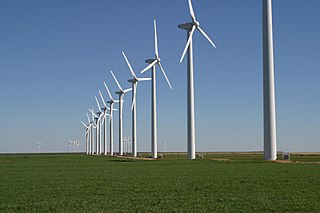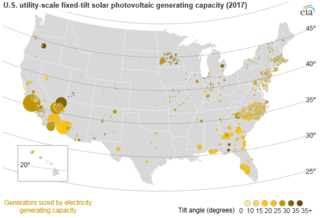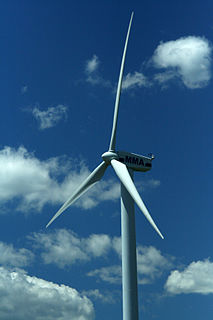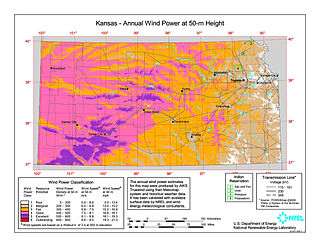
A wave farm – or wave power farm or wave energy park – is a collection of machines in the same location and used for the generation of wave power electricity. Wave farms can be either offshore or nearshore, with the former the most promising for the production of large quantities of electricity for the grid. The first wave farm was constructed in Portugal, the Aguçadoura Wave Farm, consisting of three Pelamis machines. The world's largest is planned for Scotland.
The Office of Energy Efficiency and Renewable Energy (EERE) is an office within the United States Department of Energy. Formed from other energy agencies after the 1973 energy crisis, EERE is led by the Assistant Secretary of Energy Efficiency and Renewable Energy, who is appointed by the President of the United States and confirmed by the U.S. Senate. Kelly Speakes-Backman was appointed Acting Assistant Secretary in January 2021.

Renewable energy commercialization involves the deployment of three generations of renewable energy technologies dating back more than 100 years. First-generation technologies, which are already mature and economically competitive, include biomass, hydroelectricity, geothermal power and heat. Second-generation technologies are market-ready and are being deployed at the present time; they include solar heating, photovoltaics, wind power, solar thermal power stations, and modern forms of bioenergy. Third-generation technologies require continued R&D efforts in order to make large contributions on a global scale and include advanced biomass gasification, hot-dry-rock geothermal power, and ocean energy. As of 2012, renewable energy accounts for about half of new nameplate electrical capacity installed and costs are continuing to fall.

Wind power in the United States is a branch of the energy industry that has expanded quickly over the latest several years. From January through December 2020, 337.5 terawatt-hours were generated by wind power, or 8.42% of all generated electrical energy in the United States. In 2019, wind power surpassed hydroelectric power as the largest renewable energy source generated in the U.S.

According to preliminary data from the US Energy Information Administration, renewable energy accounted for about 12.6% of total primary energy consumption and about 19.8% of the domestically produced electricity in the United States in 2020.

The developing nations of Africa are popular locations for the application of renewable energy technology. Currently, many nations already have small-scale solar, wind, and geothermal devices in operation providing energy to urban and rural populations. These types of energy production are especially useful in remote locations because of the excessive cost of transporting electricity from large-scale power plants. The applications of renewable energy technology has the potential to alleviate many of the problems that face Africans every day, especially if done in a sustainable manner that prioritizes human rights.
A feed-in tariff is a policy mechanism designed to accelerate investment in renewable energy technologies by offering long-term contracts to renewable energy producers. Their goal is to offer cost-based compensation to renewable energy producers, providing price certainty and long-term contracts that help finance renewable energy investments. Typically, FITs award different prices to different sources of renewable energy in order to encourage development of one technology over another. For example, technologies such as wind power and solar PV, are awarded a higher price per kWh than tidal power. FITs often include a "degression", a gradual decrease of the price or tariff, in order to follow and encourage technological cost reductions.
Chile's total primary energy supply (TPES) was 36.10 Mtoe in 2014. Energy in Chile is dominated by fossil fuels, with coal, oil and gas accounting for 73.4% of the total primary energy. Biofuels and waste account for another 20.5% of primary energy supply, with the rest sourced from hydro and other renewables.

Solar power in the United States includes utility-scale solar power plants as well as local distributed generation, mostly from rooftop photovoltaics. As of the end of 2020, the United States had 97,275 megawatts (MW) of installed photovoltaic and concentrated solar power capacity combined. In 2018, utility scale solar power generated 66.6 terawatt-hours (TWh), 1.66% of total U.S. electricity. During the same time period total solar generation, including estimated small scale photovoltaic generation, was 96.1 TWh, 2.30% of total U.S. electricity. In terms of total cumulative installed capacity, by year end 2017 the United States ranked 2nd in the world behind China. In 2016, 39% of all new electricity generation capacity in the country came from solar, more than any other source and ahead of natural gas (29%). By 2015, solar employment had overtaken oil and gas as well as coal employment in the United States. In 2016, more than 260,000 Americans were employed in the solar industry.
New York ranked 11th in the United States at the end of 2013 for installed wind power capacity, with 1,722 MW installed. In 2016, wind power provided 2.94% of in state energy production. This increased to 3.66% in 2019.
As of 2019, renewable energy technologies provide about 17.3% of Canada's total primary energy supply. For electricity renewables provide 67%, with 15% from nuclear and 18% from hydrocarbons.
Renewable energy in Morocco represented 0.4% of the national energy balance and nearly 10% of electricity production in 2007. Renewable energy is supported by strong hydropower sources and the newly installed wind energy parks. Morocco plans a $13 billion expansion of wind, solar and hydroelectric power generation capacity and associated infrastructure that should see the country get 42% of its electricity from renewable sources by 2020. The Moroccan government is keen on increasing renewable energy production, as Morocco's January–September oil bill reached about US$1.4 billion in subsidies in 2009, registering a fall of 57.9% compared to 2008.

The U.S. state of Massachusetts has vast wind energy resources offshore, as well as significant resources onshore. The 2016 update to the Clean Energy and Climate Plan had a goal of reducing 1990 baseline greenhouse gas emissions levels by 25% by 2020. Current goals include installing 3,500 megawatts (MW) of offshore wind power in the state by 2035. However, as of Q4 2021 the state had only 120 MW of wind powered electricity generating capacity, responsible for generating 0.9% of in-state electricity production. The state has awarded contracts to two offshore projects, the 800 MW Vineyard Wind project and 804 MW Mayflower Wind project. Construction began on the Vineyard Wind 1 project on November 18, 2021, after a long fight for approval.

In the U.S. State of Kansas, wind power is the largest source of electricity, generating over 41% of the state's electricity in 2019. Kansas has a high potential capacity for wind power, second behind Texas. The most recent estimates (2012) are that Kansas has a potential for 952 GW of wind power capacity yet had only about 5.6 GW installed by year end 2018. Kansas could generate 3,102 TW·h of electricity each year, which represents over 75% of all the electricity generated in the United States in 2011. This electricity could be worth $290 billion per year.
Modern United States wind energy policy coincided with the beginning of modern wind industry of the United States, which began in the early 1980s with the arrival of utility-scale wind turbines in California at the Altamont Pass wind farm. Since then, the industry has had to endure the financial uncertainties caused by a highly fluctuating tax incentive program. Because these early wind projects were fueled by investment tax credits based on installation rather than performance, they were plagued with issues of low productivity and equipment reliability. Those investment tax credits expired in 1986, which forced investors to focus on improving the reliability and efficiency of their turbines. The 1990s saw rise to a new type of tax credit, the production tax credit, which propelled technological improvements to the wind turbine even further by encouraging investors to focus on electricity output rather than installation.
The North Carolina Solar Center is a resource center for sustainable energy programs located at North Carolina State University in Raleigh, North Carolina. When it was created in 1988, the center's focus was solar energy. The N.C. Solar Center now serves as a resource for innovative, clean energy technologies through demonstration, technical assistance, outreach and training. It also administers the Database of Incentives for Renewables & Efficiency (DSIRE), a resource providing financial incentives and policies in the energy industry.
The following outline is provided as an overview of and topical guide to wind energy:

Renewable energy in Afghanistan includes biomass, hydropower, solar, and wind power. Afghanistan is a landlocked country surrounded by five other countries. With a population of less than 35 million people, it is one of the lowest energy consuming countries in relation to a global standing. It holds a spot as one of the countries with a smaller ecological footprint. Hydropower is currently the main source of renewable energy due to Afghanistan's geographical location. Its large mountainous environment facilitates the siting of hydroelectric dams and other facets of hydro energy.

Wind power in Virginia is in the early stages of development. In March 2015, Virginia became the first state in the United States to receive a wind energy research lease to build and operate offshore wind turbines in federal waters. As of 2019, Virginia had no utility scale wind farms.
There is enormous potential for renewable energy in Kazakhstan, particularly from wind and small hydropower plants. The Republic of Kazakhstan has the potential to generate 10 times as much power as it currently needs from wind energy alone. But renewable energy accounts for just 0.6 percent of all power installations. Of that, 95 percent comes from small hydropower projects. The main barriers to investment in renewable energy are relatively high financing costs and an absence of uniform feed-in tariffs for electricity from renewable sources. The amount and duration of renewable energy feed-in tariffs are separately evaluated for each project, based on feasibility studies and project-specific generation costs. Power from wind, solar, biomass and water up to 35 MW, plus geothermal sources, are eligible for the tariff and transmission companies are required to purchase the energy of renewable energy producers. An amendment that introduces and clarifies technology-specific tariffs is now being prepared. It is expected to be adopted by Parliament by the end of 2014. In addition, the World Bank's Ease of Doing Business indicator shows the country to be relatively investor-friendly, ranking it in 10th position for investor protection.









